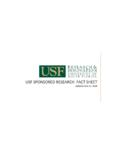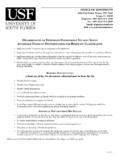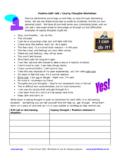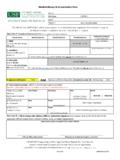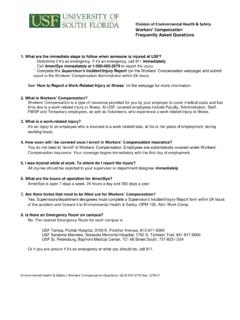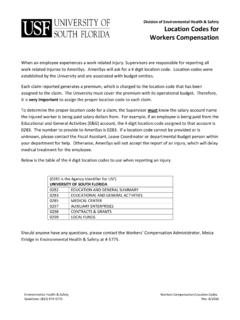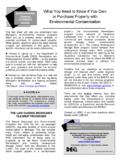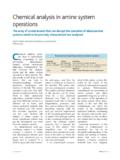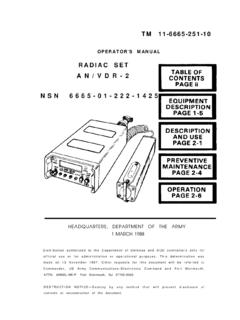Transcription of Chemical Spill Kits - usf.edu
1 Chemical Spill Kits Each laboratory has a unique composition of hazardous and non-hazardous chemicals in various states. Therefore, the Spill kit requirements of each laboratory are also unique. There are general guidelines to follow when deciding how to appropriately stock a Spill kit. Few labs are properly equipped without supplementing the basic Spill kit with items that meet the specific needs of that laboratory. These specific needs can only be determined by assessing the quantities of chemicals in the laboratory, and by consulting their MSDSs. The following are the recommended components of a basic Spill kit: Polypropylene or high-density polyethylene bucket with top (5 gallon or larger) Personal protective equipment (PPE) (safety eyewear, gloves, etc.)
2 Tools ( Chemical resistant, nonsparking (plastic) dustpan or scoop and brush, etc.) Inert absorbents (vermiculite, sand, clay, absorbent socks or pillows, etc.) Neutralizing and treatment materials (type and quantity are dependent on the laboratory s chemicals) Chemical resistant bags Hazardous waste tags Each component of the basic Spill kit will be explored below: 1. Polypropylene or high-density polyethylene bucket or container with top Purpose: To act as a receptacle for Chemical resistant bag liners during a Spill clean-up and as a storage container for the Spill kit components. Possible options: 5 gallon or larger with a lid. Other considerations: The bucket or container should be well labeled and easily accessible.
3 All faculty, students, and staff working in the lab must know where the Spill kit is located. 2. Personal Protective Equipment (PPE) A. Safety eyewear: Spare safety glasses and/or goggles should be included in the Spill kit. B. Gloves: No gloves are Chemical proof, however, some are resistant to more chemicals than others. Nitrile, neoprene, and butyl rubber gloves are some examples. Latex gloves are not resistant to most laboratory chemicals and should not be in the Spill kit. C. Aprons / Shoe covers / Lab coats / other PPE: Reading the MSDSs is the best way to ensure that all of the requirements for PPE have been fulfilled. 3. Tools Description: Clean-up tools such as dustpan, scoop and brush, etc.
4 Should be Chemical resistant and nonsparking (plastic). A variety of polypropylene tools are available. 4. Inert absorbents A. Vermiculite: Description: According to TVA (The Vermiculite Association), vermiculite is the mineralogical name given to hydrated laminar magnesium-aluminum-ironsilicate which resembles mica in appearance. It is non-combustible and inert. B. Other inert loose bulk such as clay, sand, or kitty litter Description: When used correctly, loose bulk can prevent a liquid Spill from spreading. Considerations: Paper towels, rags, and sawdust are not inert materials. They are combustible and may react with a variety of chemicals. C. Commercial pillows, socks, pads, particulates, etc.
5 Description: Many nonselective amorphous silicate sorbents and polypropylene sorbents are available as socks, pillows, diking tubes, etc. Considerations: See manufacturers product information for product limitations. D. Other Considerations Some chemicals require special precautions and all absorbents have limitations. 5. Neutralizing and treatment materials A. Acids Spills: Sodium bicarbonate, sodium carbonate, and commercial kits designed for acid spills are sufficient for neutralizing many acids. Some of the commercial kits have color indicators to show when a Spill has been neutralized. B. Alkali Spills: Citric acid, sodium bisulfate, and commercial kits designed for alkali or caustic spills are sufficient for neutralizing many bases.
6 Some of the commercial kits have color indicators to show when a Spill has been neutralized. C. Solvent Spills: Commercial solvent treatment materials may be used to reduce vaporization and raise the flash points of some solvents. D. Other considerations: There are other Chemical specific materials that may be necessary to safely and effectively neutralize or treat some Chemical spills. 6. Chemical resistant bags All Spill residue and Spill clean-up material needs to be placed in a high density polyethylene or polypropylene bag with attached hazardous waste tag. 7. Hazardous waste tags Tags can be picked up at EH&S (CRS 104) or sent to you via campus mail by calling 4-4036. This information sheet contains general recommendations for the core components of a Spill kit.
7 The quantity and potential hazard of chemicals must be considered and MSDSs must be consulted before a Spill kit is completely stocked. Please contact EH&S (4-4036) if you have any questions.
